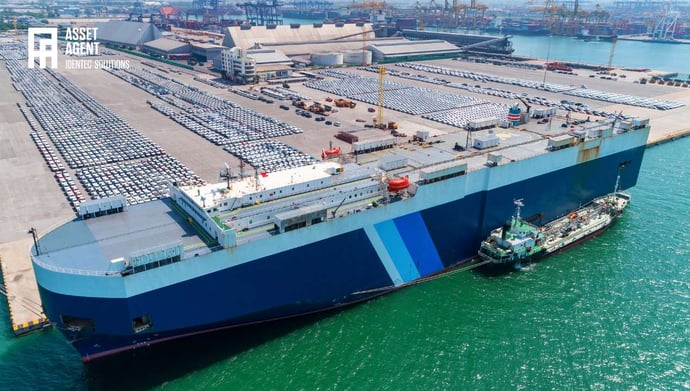Car Terminals: Get them ready for the Next Decade
| Written by Mark Buzinkay

No video selected
Select a video type in the sidebar.
Today's Challenges in Car Terminals
Port congestion remains a major issue in vehicle logistics, driven by increasing car volumes and limited terminal space. Supply chain disruptions have exacerbated the problem by causing unpredictable shipping schedules. Many ports were not designed to handle today's scale of vehicle shipments, leading to overcrowding and inefficient space utilization. Large car carriers, capable of transporting thousands of vehicles at once, add further pressure as ports struggle to process these shipments quickly. Expansion is difficult, especially in urban areas where land is scarce, leaving ports with few options beyond automation and vertical storage solutions—both requiring significant investment. Without improved infrastructure and logistics management, congestion will continue to delay deliveries and increase costs.
Labour shortages further strain car terminal operations. Ports require a steady workforce for unloading, inspecting, and processing vehicles, but an ageing workforce and a lack of younger replacements have led to staffing gaps. The physically demanding nature of the job, long shifts, and changing labour market preferences make recruitment difficult. The COVID-19 pandemic worsened the situation, as many workers left and did not return. A shortage of skilled drivers, essential for moving cars within terminals, has further slowed operations. Stricter licensing and training requirements make it challenging to fill these roles quickly, contributing to delays and inefficiencies.
Pre-delivery inspections (PDIs) and compliance documentation add complexity to vehicle processing. Modern cars require thorough inspections to ensure mechanical, electrical, and cosmetic integrity before delivery. These processes are time-consuming, require specialized expertise, and can be inconsistent due to manual oversight. Compliance documentation, such as emissions reports and safety certifications, adds another layer of difficulty. Since regulations vary across regions, logistics providers must carefully manage documentation to avoid delays and legal issues.
A lack of visibility across terminal operations worsens logistical inefficiencies. Security concerns arise as vast storage areas become vulnerable to theft and vandalism, necessitating improved surveillance. Poor inventory tracking leads to underutilized or overcrowded storage, complicating vehicle dispatch and increasing costs. Fragmented tracking systems cause discrepancies between physical inventory and digital records, disrupting supply chains—especially in just-in-time manufacturing environments.
Car Terminals: Yard loading operations
Car terminals serve a core purpose: connecting vehicle production centres to their sale destinations. The smooth flow of vehicles in and out of the terminal is vital, necessitating optimal road, rail, and sea access.
Volkswagen in Bremerhaven and Nissan in Zeebrugge use adjacent logistic centres for temporary vehicle storage before transferring them to the terminal. This approach frees terminal storage and gives manufacturers better stock control.
In contrast to road transport, rail transport links distant production centres to ports and offers cost efficiency and safety. Sea transport involves transshipments from other vessels, where vehicles from transcontinental factories are first discharged at hub terminals like Barcelona or Antwerp and then redistributed to nearby ports.
However, these roro cargo movements necessitate continuous entry and exit from customs territories, influencing customs regulations.
In most cases, the actual loading operation at the terminal isn't done by terminal staff but by externally hired stevedore gangs of lashers, drivers, and team leaders. These gangs operate in shifts, with extra costs for night, early morning, weekends, and holidays. Vehicles are typically positioned near the vessel according to the stowage plan to prepare for loading according to their brand, model, and destination. In a final step, stevedores drive and lash the vehicles in the vessel's holds. For efficiency, terminals select berths closest to designated vehicles to minimize vehicle movement.
All of these activities require space, people, and visibility into the current status quo of operations, which is not different from unloading operations, as we will see next.

Car Terminals: Unloading operations
The unloading process of vehicles from a car carrier follows a structured sequence to ensure efficiency and safety. Once the vessel is moored securely, the unloading process begins under the coordination of the terminal operations manager. Trained vehicle handlers, also known as drivers or marshals, enter the vessel's hold to begin driving the vehicles off the ship. Ground staff, positioned along the unloading path, guide the drivers and ensure a smooth flow. As each vehicle exits the vessel, it passes through an initial checkpoint where inspectors verify its identification number against the cargo manifest. This document, provided by the shipping company, lists all the vehicles on board and their designated recipients.
Once the vehicles reach the designated parking area within the terminal, they undergo a more detailed inspection by the pre-delivery inspection (PDI) team. This team checks for any transport-related damages such as scratches, dents, or missing parts and records them in an inspection report. In some cases, minor repairs are performed at the terminal's PDI facility before the vehicles proceed further in the supply chain.
After the inspection, each vehicle's documents, including customs clearance papers, import declarations, and homologation certificates, are processed. The customs officers verify the paperwork to ensure compliance with local import regulations.
Once the documentation is cleared, the vehicles are prepared for shipment to the hinterland. Logistics coordinators allocate vehicles to the appropriate mode of transport based on destination, urgency, and cost considerations, and they drive them to the corresponding loading areas (rail, truck, and barges).
Before the vehicles leave the terminal, a final verification process takes place to match them with the transport documents, such as waybills and delivery notes. The transport drivers receive their assigned paperwork, which includes vehicle details, destination, and expected delivery timelines. The terminal dispatchers authorize the shipment's release, ensuring that all required formalities are completed.
How to improve car terminals?
There is a notable lack of standardization in the maritime roro transport of vehicles compared to other industrial and logistics sectors. Everyone does it his own way due to missing best practices, industrial norms, and continuously changing economic challenges. The lack of standardization often leads to inefficiencies, errors, and compromises in safety, prompting the important question, "How can this be improved?"
One pressing challenge in car terminal operations is smarter space utilization. Vertical storage solutions can increase capacity without expanding terminal footprints, though they require significant investment. Reconfiguring yard layouts to improve vehicle flow can also help alleviate congestion. Enhancing real-time inventory management is another key solution, as outdated tracking methods often lead to misplaced vehicles and inefficiencies. By integrating RFID and GPS tracking, terminals can precisely locate and allocate storage for vehicles, reducing search times and maximizing space. Coordination between port authorities, shipping lines, and land transport providers is also essential to ensure a seamless flow of vehicles, minimizing storage delays and optimizing terminal capacity.
To streamline pre-delivery inspections (PDI) and compliance documentation, the automotive industry is shifting toward automation and digitization. Standardized digital checklists can minimize human error and create consistency across inspections. Automated PDI stations, equipped with robotics and imaging technology, can swiftly detect defects like scratches or missing components, reducing inspection times and improving accuracy. Digital platforms also enhance compliance management, ensuring regulatory requirements are met without administrative delays.
Improving visibility across terminal operations is critical for addressing security, storage, and inventory challenges. End-to-end supply chain visibility tools, such as RFID or Bluetooth beacons, provide real-time vehicle tracking, preventing inventory discrepancies and optimizing space utilization. Strengthening security through a hybrid model—integrating live monitoring systems with physical patrols—can reduce theft and unauthorized access, further safeguarding vehicle storage areas.
Labour shortages continue to impact terminal efficiency, prompting the adoption of automation solutions. Digital tracking systems come here handy as you can do more with less. Without a sustainable workforce strategy, car terminals will struggle with delays.
Technical answers
One way to improve the process of RoRo transport operations is by combining digital tracking with automated job promotion. One exciting solution is to use the VIN (vehicle identification number), a handheld device to scan the VIN and register the vehicle's location, and a software application that controls the loading/unloading process by syncing the progress with the stowage, respectively, parking plan.
In this scenario, the stevedore/driver scanning the VIN gets the parking slot at the vessel on the device's screen and scans the VIN again once he delivers the car to the defined spot. The head of the stevedore gang also scans the VIN once the car is leashed to finalize the loading process. This enables the vessel's captain to see the progress of loading and understand the proper weight balance on his vessel. It is also clear to the system which vehicle has been taken from the parking lot in which order by which driver, leading to better transparency in terms of damage control, performance and theft.
The same procedure can be applied when unloading a car carrier. Additionally, the new parking lot for unloaded cars can be recorded by scanning the VIN at arrival in the yard. As many car importers use their RoRo port terminal as an extensive garage, every single step in the finishing process, like tyre change, adding custom parts, cleaning, fueling, and more, can be recorded by scanning the VIN with the mobile device that supports a software application like Asset Agent.
An alternative solution to this scenario involves a mobile transponder that transmits an individual identification. This Radio Identification can be received by readers placed on strategic points of the entire operation to virtually see every single move from every vehicle involved automatically and in real-time. No manual interaction, such as scanning the VIN, is needed with this solution.
FAQ: Solving Challenges in Car Terminal Operations
How can car terminals reduce congestion and maximize space efficiency?
Car terminals can reduce congestion by adopting vertical storage solutions, which increase capacity without expanding the footprint. Optimizing yard layouts improves vehicle flow, reducing bottlenecks. Implementing real-time inventory management with RFID and GPS tracking prevents misplaced vehicles and ensures efficient space utilization. Additionally, better coordination between port authorities, shipping lines, and transport providers can minimize dwell times by streamlining the movement of vehicles through the terminal.
What role does automation play in addressing labour shortages at car terminals?
Automation helps offset labour shortages by introducing autonomous vehicle movers, digital tracking systems, and automated pre-delivery inspection (PDI) stations. These solutions reduce reliance on human labour while improving operational efficiency. Digital checklists and robotics enhance inspection accuracy, while automated vehicle loading and unloading systems decrease turnaround times. Although automation requires initial investment, it ensures long-term stability in operations despite workforce constraints.
How can visibility improvements enhance security and inventory management at car terminals?
Enhanced visibility through RFID tags, Bluetooth beacons, and live monitoring systems helps track vehicle movements in real time, reducing the risk of misplaced inventory and unauthorized access. Hybrid security models that integrate surveillance technology with on-ground security personnel strengthen protection against theft and vandalism. Digital tracking solutions also streamline inventory management by providing instant access to vehicle locations, preventing operational delays and improving overall efficiency.
Takeaway
Enhancing car terminal operations requires a combination of smarter space utilization, automation, and improved coordination. Vertical storage solutions and optimized yard layouts can alleviate congestion, while real-time inventory tracking using RFID and GPS minimizes inefficiencies. Automating pre-delivery inspections and compliance documentation with robotics and digital platforms reduces processing times and errors. Additionally, addressing labour shortages through automation and digital tracking helps maintain operational efficiency, and end-to-end visibility tools enhance security and inventory management.
Glossary
Pre-delivery inspections (PDI) are comprehensive quality control checks performed on vehicles before they reach customers. These inspections ensure that vehicles meet manufacturer specifications and regulatory requirements by assessing mechanical functions, electrical systems, and exterior conditions. They also include fluid level checks, software updates, and safety feature verifications. PDIs help detect and resolve any transit-related damage or defects before delivery. (2)
Sources:
(1) https://shippingwatch.com/article16675415.ece
(2) Schmidt, W. (2017). Automotive Quality Systems Handbook. Butterworth-Heinemann.

Author
Mark Buzinkay, Head of Marketing
Mark Buzinkay holds a PhD in Virtual Anthropology, a Master in Business Administration (Telecommunications Mgmt), a Master of Science in Information Management and a Master of Arts in History, Sociology and Philosophy. Mark spent most of his professional career developing and creating business ideas - from a marketing, organisational and process point of view. He is fascinated by the digital transformation of industries, especially manufacturing and logistics. Mark writes mainly about Industry 4.0, maritime logistics, process and change management, innovations onshore and offshore, and the digital transformation in general.
Related Articles
Related Product



